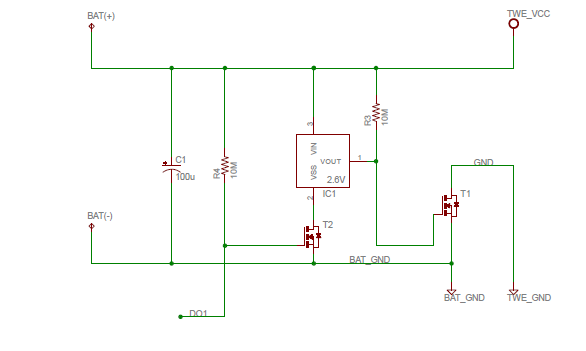About the Reset Circuit
The module starts up after exceeding the startup voltage (typical 2.05V). When the voltage drops by Vhys = 38mV from the startup voltage, the reset is triggered again.
The considerations are as follows:
- Use an external reset IC to start up at a higher voltage point
- Provide sufficient voltage buffering on the power supply line

Circuit Example
Watchdog
The TWE module includes a watchdog timer function, but if the module experiences unexpected electromagnetic shocks, there is a possibility that it may hang.
The considerations are as follows:
- Forced reset by external watchdog hardware
Periodic Reset
When long-term operation of the system has not been sufficiently confirmed, it is necessary to consider forcibly resetting the wireless system periodically.
The considerations are as follows:
- Reset periodically by software
- Control the RESETN pin by external hardware to force a reset
Handling of Unused Pins
For unused pins, leaving them open is recommended, but depending on the hardware design approach, consider the following:
- External pull-up for digital-related pins
- Pull-down or pull-up for analog-related pins (opening is recommended in the semiconductor datasheet)
Power Supply
A power supply with less noise and more stability is recommended.
- Use of low-noise series regulators, etc.
- Power supply voltage set between 2.7V and 3.3V
- Use of buffer capacitors when using dry batteries
- Insertion of bypass capacitors on the power line (may reduce ADC noise)
Electromagnetic Noise via Antenna
Electromagnetic noise may enter through the antenna path.
- Surge protection on the antenna path (separate certification is required)
- Forced reset by the above external watchdog
Various Noises
Operation may be affected by or affect signal lines, microcontrollers, motors, and other peripheral devices. Also, wireless transmission and reception emit a certain level of electromagnetic noise, so the impact on other systems should be considered.
In hobby applications, the need for this is considered low, but depending on system requirements, such considerations may be necessary.
- Specialized design verification and consideration are required.
Firmware
These are methods to consider when seeking reliability in firmware. Some items may not be considered for general applications.
Below are some common methods introduced:
- Use of hardware watchdog (TWELITE NET uses the semiconductor’s internal watchdog within the library)
- Use of voltage detection interrupts (BrownOut detection)
- Periodic forced reset (not implemented in standard applications)
- Periodic checking and redundancy of memory and variables (not implemented in standard applications)
- Use of stack overflow APIs
- Firmware checksum verification at startup (not implemented in standard applications)
- Encryption of communication and check with redundant data (encryption communication such as App_UART strengthens data verification)
- Strengthening checksum of UART input/output (App_UART uses 8-bit checksum by xor)